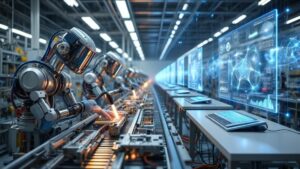AI for Predictive Maintenance and Preventative Maintenance
The goal of Artificial Intelligence (AI) is to speed up the automation of formerly manual processes by making them behave more like humans while doing certain tasks. When it comes to predictive and preventive maintenance, AI solutions examine present operating states of hardware or software and look for minor signs of possible problems before they ever happen. Artificial Intelligence algorithms can detect small drops in operational efficiency, indicating the need for repairs, by carefully comparing real-time performance with previous data.
With this cutting-edge feature, staff become better informed of upcoming maintenance needs. With this foresight, teams may anticipate problems and fix them before they occur by focusing on individual parts. In short, AI is a strategic ally in the search for optimum equipment functioning and therefore, serves as a task streamliner. Research shows that by tackling problems before they exacerbate and get out of hand, predictive maintenance enabled by AI can greatly decrease downtime and improve overall operational efficiency.
Essential Components of Artificial Intelligence
Artificial Intelligence (AI) systems for predictive and preventive maintenance rely on two primary components: Machine Learning (ML) algorithms and easy access to trustworthy data. These important parts are essential for AI tools to work smoothly in the repair field. Now, let’s talk about the important parts:
- Data Accessibility: The capacity to obtain data effortlessly is the fundamental component of AI. Continual access to both past and present data is essential for these AI systems to assess performance and forecast maintenance needs. Included in this are specifics of how each operation functions, how it fits into the larger manufacturing process, and whether or not there are any unusual occurrences.
- Algorithms as the Key Elements: Algorithms are becoming increasingly important as we shift towards predictive maintenance and Machine Learning. These algorithms function as a comprehensive set of rules and instructions that enable the analysis of data and the identification of correlations within it. These algorithms have the ability to continuously evolve, recognizing patterns in data as time progresses. The most important feature of Machine Learning algorithms is their ability to distinguish between valuable information (signals) and irrelevant data (noise).
- AI’s Link to Industry 4.0: The effectiveness of AI in predictive maintenance is closely tied to the emergence of Industry 4.0, which is defined by the seamless integration of manufacturing technologies via the Industrial Internet of Things (IIoT). Within the realm of these smart factories, companies have the opportunity to access vast datasets that can be utilized for predictive maintenance initiatives. However, the achievement of these benefits relies on the successful implementation of appropriate Machine Learning algorithms and AI frameworks. It is important to highlight that the incorporation of AI in this particular scenario is in line with the significant impact of Industry 4.0, bringing forth a fresh era of maintenance strategies that are driven by data and proactive measures.
Unlocking Business Value through Effective Maintenance
Controlling hardware and software tools strategically is a key part of long-term business success. Organizations can strengthen their bases for long-term success and growth by carefully looking at important factors like limiting operational fallout, maximizing return on investment, giving employees more power, supporting procurement efficiency, improving safety protocols, quality control, and managing environmental impact. By looking into these areas, we can see how a proactive AI-driven approach to maintenance could change everything, bringing about a new era of operating security and value creation that goes beyond the old ways of doing things.
Limiting Operational Fallout:
Trying to predict and prevent equipment failures is an effective strategy to prevent disruptions in operations that could adversely affect other critical processes. Proactive handling of potential problems lowers the risk of loss, ensuring smoother and uninterrupted operations, thereby mitigating operational fallout.
Enhancing Return on Investment (ROI):
Preventing hardware or software breakdowns extends beyond immediate cost savings; it maximizes the return on investments. Businesses extract the most value from their assets by extending their operational life, contributing to long-term financial stability and efficient resource utilization.
Empowering the Workforce:
Proactive maintenance transforms maintenance teams from immediate rescuers to strategic predictors. By reducing the immediate workload, teams gain the capacity to spend more time analyzing trends, predicting problems, and taking preventive measures. This empowerment of the workforce optimizes the utilization of valuable human capital.
Supporting Procurement Efficiency:
Knowledge of when new components will be needed is a crucial benefit for improving procurement efficiency. Efficient scheduling and acquisition of replacement parts become possible, particularly valuable in the face of continuous supply chain interruptions. This strategic planning optimizes capital allocation by reducing on-site spare equipment.
Enhancing Safety Protocols:
Anticipating and averting operational breakdowns is a key step towards enhancing enterprise-wide safety measures. Swift action to eliminate potential dangers ensures a safe workplace for employees and protects assets. Proactive measures contribute to a comprehensive approach to ensuring a secure working environment.
Improving Quality Control:
Assets nearing collapse can compromise product quality, impacting a company’s reputation. To maintain consistent quality, it is essential to address potential problems through preventative measures and maintenance before they impact production. This method enhances robust quality control procedures, ensuring products meet desired specifications.
Managing Environmental Impact:
Both operational efficiency and environmental sustainability are favorably impacted by the use of predictive maintenance. Businesses may lessen their impact on the environment by making better use of the resources used for maintenance, such as replacement parts and shop supplies. Responsible and environmentally friendly operating techniques are gaining prominence, and this fits nicely with that trend.
Among the many potential advantages of predictive maintenance as a strategy are enhanced operational resilience, long-term financial viability, employee agency, and ecological consciousness. To get the most out of these proactive methods for a company, it’s important to apply and integrate them into current operational frameworks.
AI in Predictive Maintenance
By providing sophisticated capabilities beyond conventional reactive methods, Artificial Intelligence (AI) is playing an integral part in transforming predictive maintenance. To further understand how AI improves predictive maintenance plans, consider the following:
Data Analysis and Pattern Recognition:
AI excels in processing vast amounts of data with speed and precision. Through sophisticated Machine Learning algorithms, AI analyzes historical and real-time data to identify subtle patterns and anomalies in equipment performance. This allows for the early detection of potential issues, enabling proactive intervention before a breakdown occurs.
Optimizing Maintenance Schedules:
AI algorithms consider historical data, equipment usage patterns, and environmental factors to optimize maintenance schedules. This ensures that maintenance activities are performed when necessary, minimizing downtime and reducing unnecessary maintenance costs, effective maintenance strategies, and empowering maintenance teams with actionable insights.
Cost Reduction and Efficiency Improvement:
By facilitating early detection of equipment issues and optimizing maintenance practices, AI contributes to significant cost reductions and operational efficiency improvements. This transformative impact goes beyond merely preventing breakdowns; it establishes a proactive and data-driven approach to maintenance management.
Failure Mode Analysis:
AI excels in conducting comprehensive failure mode analysis by considering various parameters and historical data. This in-depth analysis helps organizations understand the specific failure modes of their equipment, enabling them to implement targeted preventive measures.
Anomaly Detection in Sensor Data:
AI-powered systems excel at detecting anomalies in sensor data. By continuously monitoring sensor readings, AI can identify deviations from normal behavior, providing early warnings for potential issues and enabling timely preventive actions.
Benchmarking Performance Metrics:
AI benchmarks performance metrics against industry standards and historical data. This allows organizations to identify areas where their equipment performance deviates from the norm, facilitating targeted preventive measures to bring performance in line with optimal standards.
Supply Chain Integration for Parts Availability:
AI integrates with supply chain data to predict when specific replacement parts will be needed. This ensures that required parts are available when scheduled preventive maintenance is due, reducing downtime and optimizing the supply chain.
Root Cause Analysis:
In the event of equipment failures, AI conducts root cause analysis by exploring the historical data. This aids in understanding the underlying causes of failures, enabling organizations to implement preventive measures addressing the root issues.
Learning from Unplanned Downtime Events:
AI learns from unplanned downtime events and adjusts preventive maintenance strategies accordingly. This adaptive learning process ensures continuous improvement, refining preventive measures based on real-world performance data.
AI for Preventative Maintenance
As an altering force, Artificial Intelligence (AI) changes the way things are done and pushes businesses towards higher working efficiency. AI plays a big part in preventative maintenance because it is very good at analyzing data, finding patterns, and making predictions. This is a list of the many ways that AI makes preventive maintenance methods better:
Condition Monitoring in Real Time:
AI-driven sensors continuously monitor equipment conditions in real time. These sensors detect variations in temperature, vibration, and other relevant parameters, providing valuable insights into the health of both software and hardware. This real-time condition monitoring allows for timely preventive actions to be taken, preventing potential failures.
Proactive Identification of Maintenance Needs:
Leveraging Machine Learning algorithms, AI proactively identifies maintenance needs based on data trends. By understanding how equipment behaves over time, AI can predict when components are likely to require attention, enabling organizations to schedule preventive maintenance activities and avoid unexpected breakdowns.
Optimizing Maintenance Schedules:
AI algorithms consider various factors, including historical data, usage patterns, and environmental conditions, to optimize preventive maintenance schedules. This ensures that maintenance activities are conducted at the most opportune times, minimizing disruption to operations and maximizing the lifespan of equipment.
Prescriptive Maintenance Recommendations:
AI not only predicts potential issues but also provides prescriptive recommendations for preventive maintenance actions. By pinpointing specific components that may need attention, AI guides maintenance teams in executing effective preventive measures, preventing the occurrence of failures.
AI helps with preventive maintenance by looking at huge amounts of data, predicting problems that might happen, and directing early actions. This not only lowers the chance of problems happening out of the blue, but also makes equipment more efficient and reliable overall, encouraging a proactive and cost-effective approach to repair.
Conclusion
Artificial Intelligence (AI) has emerged as a powerful tool in predictive and preventive maintenance. By utilizing Machine Learning algorithms and readily available data, AI can greatly improve scheduling, cut down on costs, and boost operational efficiency. In line with the advancements of Industry 4.0, AI plays an integral part in enabling a proactive approach by accurately predicting and preventing potential issues before they have a chance to disrupt operations. The advantages are evident in enhanced safety measures, stringent quality control, and a commitment to responsible environmental practices. Through data analysis, pattern recognition, and actionable insights, AI becomes a valuable partner, guaranteeing equipment reliability and promoting a proactive and cost-effective maintenance approach. This ultimately contributes to long-term business success. RTS Labs is a highly professional Enterprise AI consulting company specializing in the development of custom AI solutions. With a strong background in data engineering, MLOps, and DevOps, they are ideal for helping predict and prevent any maintenance-related issues from harming your business.






